



















|
 |
|
 |

The Casse rely on skirmishers in early armies, but progressively more shock infantry. They support their armies with chariots, light horsemen, and most importantly, 'champions' of various types. Most of their units have lower than average morale, but many higher upkeep units raise allied morale, to encourage the Britons to continue to fight.
This unit list shows Casse troops and regional Briton units. Heavier infantry and other units can be raised from regions outside Britain, like Goidlic infantry from Ireland and Belgae cavalry from northern Gaul.
Lugoae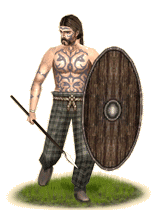 During periods of strife and war, it is necessary sometimes to call upon ordinary citizens to organize as militia. Militia in Celtic societies, called Lugoae (Lug-oo-ay; "Levy Troops"), are farmers, craftsmen, fishermen, and so on, called to brief military service in periods of crisis. They may train a few times a year to fight, and games and sports encourage a decent level of physicality, but they're still only militia, and can only be trusted to do so much.
During periods of strife and war, it is necessary sometimes to call upon ordinary citizens to organize as militia. Militia in Celtic societies, called Lugoae (Lug-oo-ay; "Levy Troops"), are farmers, craftsmen, fishermen, and so on, called to brief military service in periods of crisis. They may train a few times a year to fight, and games and sports encourage a decent level of physicality, but they're still only militia, and can only be trusted to do so much.
Historically, the Celts, being a warrior culture, encouraged their people to engage in sports and games that would increase their physical strength and preparedness for war. This doesn't mean everyone was a warrior though. Those not in the warrior class would be levied into warbands at times, or form their own militias in their towns to defend themselves from outsiders and act as a type of early police force. Their weapons and equipment would be whatever they could afford personally, usually simple hunting implements, such as a hunter's spear, and a shield.
Imannae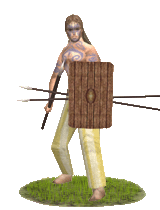 The Imannae (Im-an-ay; Ambushers) are youths used throughout many less developed Celtic territories to ambush and disorient enemies. In an army, they generally act as a screen before the main force, loosening the enemy formations before the older warriors charge. They are actually more akin to a militia arm, and are employed by tribes in dire need of defense; they are best employed as hit-and-run soldiers. If left into a melee, they will break and flee. The Imannae (Im-an-ay; Ambushers) are youths used throughout many less developed Celtic territories to ambush and disorient enemies. In an army, they generally act as a screen before the main force, loosening the enemy formations before the older warriors charge. They are actually more akin to a militia arm, and are employed by tribes in dire need of defense; they are best employed as hit-and-run soldiers. If left into a melee, they will break and flee.
Historically, the Celts had to rely heavily on skirmishers when their armies were weakened. However, they also used them to weaken campaigning and marching foes, and as a light warband for raids, as well as screen their armies. They were very prolific ambushers; most Celtic territory was wooded with many places to launch such attacks from, and these types of soldiers would be of most use in similar terrains. As young men still trying to raise their status, it is unlikely they were very sturdy in a prolonged battle. It was not unusual for such 'warriors' to take up jobs as mercenaries, to ensure better pay than they could normally get for their station, and some probably even went into outright banditry.
Cemmeinarn (Briton Midland Spearmen)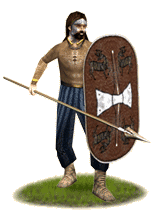 Cemmeinarn (Kem-ay-nayrn; "Marching Ones") are the mainstay of most midlander armies. They carry spears to be thrown before a charge, and engage with well made melee long-spears. They are unarmored, have a good shield, and are capable in battle. Appropriately supported by skirmishers, they can be quite useful in engaging most threats, though they are incapable of lasting against truly heavy infantry. A frontal attack, however, can be thwarted if the Cemmeinarn stand together; their shields provide them good defense from the front, and their armor gives them some light protection, but from the sides or flanks, the Cemmeinarn are incapable of defending themselves well and will likely be slaughtered. However, Cemmeinarn are only semi-professionals, and only the most experienced will readily hold together under the weight of a strong charge. Cemmeinarn (Kem-ay-nayrn; "Marching Ones") are the mainstay of most midlander armies. They carry spears to be thrown before a charge, and engage with well made melee long-spears. They are unarmored, have a good shield, and are capable in battle. Appropriately supported by skirmishers, they can be quite useful in engaging most threats, though they are incapable of lasting against truly heavy infantry. A frontal attack, however, can be thwarted if the Cemmeinarn stand together; their shields provide them good defense from the front, and their armor gives them some light protection, but from the sides or flanks, the Cemmeinarn are incapable of defending themselves well and will likely be slaughtered. However, Cemmeinarn are only semi-professionals, and only the most experienced will readily hold together under the weight of a strong charge.
Historically, the midlanders lacked many swords. As such, they relied heavily upon spearmen, even in more advanced armies. They would carry javelins, and be outfitted in such a way to serve many roles on the field. A spear can bring down a horse or man, a large shield can deflect missiles and swords and other spears, and javelins can bring down a charging warrior, even on a chariot or horseback. These warriors' versatility coupled with relative low expense would be their greatest asset; however, the midlanders also had very few professional soldiers. These men are likely more experienced as farmers or tradesmen than soldiers, but more experienced than militias, as their chief likely organized them to train to some extent.
Gaeroas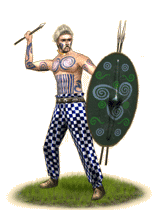 Gaeroas (Guy-rows; "Spear Soldiers") are the file warriors of the tribes of Gaul and Britain. The Gaeroas all utilize well-made long spears, and a few decent javelins, making them both fair melee warriors and impromptu skirmishers. Their versatility, and low relative expense, mean they are a fine warrior band for enterprising warlords looking to expand their lands. They have some experience with combat, but are not yet hardened to battle. However, they are trained well enough to march in a good formation, something actually lost on greater warriors for the Britons. Their longspears may seem a bit unwieldy, but this is likely to help them in combating cavalry and chariot horses as a unit. While unarmored, they have large oval shields, which provides them a good amount of protection. They are fairly well trained with these shields, and they provide a fair amount of protection from ranged attacks, but the lack of armor makes them quite vulnerable to flanking.
Gaeroas (Guy-rows; "Spear Soldiers") are the file warriors of the tribes of Gaul and Britain. The Gaeroas all utilize well-made long spears, and a few decent javelins, making them both fair melee warriors and impromptu skirmishers. Their versatility, and low relative expense, mean they are a fine warrior band for enterprising warlords looking to expand their lands. They have some experience with combat, but are not yet hardened to battle. However, they are trained well enough to march in a good formation, something actually lost on greater warriors for the Britons. Their longspears may seem a bit unwieldy, but this is likely to help them in combating cavalry and chariot horses as a unit. While unarmored, they have large oval shields, which provides them a good amount of protection. They are fairly well trained with these shields, and they provide a fair amount of protection from ranged attacks, but the lack of armor makes them quite vulnerable to flanking.
Historically, spearmen in Britain and Gaul would have been the young to middle-age warriors, who had not risen greatly in prestige, or who had chosen to continue to fight as a lower warrior. They would use well-made, but not truly exceptional spears, and javelins for skirmishing. This allowed their most basic warriors to perform two duties, and allocate other soldiers to more specialized positions. Their equipment would be self maintained, and they would be expected to keep their weapons and shield in good condition. They likely paid for their own equipment, but spears and javelins are relatively cheap, the most expensive part of their equipment was likely the shield. These warriors represent the most basic professional warriors of almost all of the aforementioned tribes. They would be highly viable for the warchief who couldn't afford to bring in many swords or other weapons for his tribe.
Gaelaiche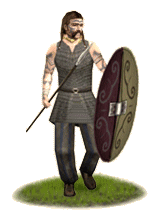 Celtic warbands have always largely relied on spears. The Gaelaiche (Guy-latch; "Spear-Warriors") are the lightest members of the Celtic warrior class. They carry cheap equipment; Celtic longspears, javelins, and a shield. However, they have their uses. Their spears are good against horsemen, and can be used to good affect against infantry as well, and their javelins can be used as a fine method to disorient a foe. Experienced spearmen are a great asset to a campaigning Celtic army, and even inexperienced spearmen are generally superior to any early levies that can be produced. The many transalpine Gallic tribes arm themselves in this manner, but also a handful of tribes in southwest Britain also use such armaments and fighting style.
Celtic warbands have always largely relied on spears. The Gaelaiche (Guy-latch; "Spear-Warriors") are the lightest members of the Celtic warrior class. They carry cheap equipment; Celtic longspears, javelins, and a shield. However, they have their uses. Their spears are good against horsemen, and can be used to good affect against infantry as well, and their javelins can be used as a fine method to disorient a foe. Experienced spearmen are a great asset to a campaigning Celtic army, and even inexperienced spearmen are generally superior to any early levies that can be produced. The many transalpine Gallic tribes arm themselves in this manner, but also a handful of tribes in southwest Britain also use such armaments and fighting style.
Historically, Celts always favored spears; they were easy to produce and didn't require much steel. Celtic longspears were of fair quality, with broad, sharp heads that would cause deep, terrible gashes, and could be used as well to bring down horses. They would accompany these weapons with javelins thrown into an enemy position to disorient and kill a few foes. They would probably be mostly the youngest Celtlic warriors, but there wasn't shame in an older, experienced warrior fighting with a spear as well; the spear was a respected weapon in Celtic society.
Uirodusios (Celtic Naked Spearmen)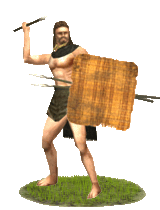 The Uirodusios (Oo-row-doo-see-os; 'Man-Demons') fight in the ancient Celtic style, stripped nude but for his torc, anklets, and bangles, and sometimes a cloak. Though poorly defended, and not nearly as skilled as the Gaesatae mercenaries of Gaul, nor on drugs, they are still formidable and present a frightening visage that unnerves enemies. These are not so much an elite as they are often only somewhat experienced warriors who wish to increase their fame by daring acts of bravery. The Uirodusios (Oo-row-doo-see-os; 'Man-Demons') fight in the ancient Celtic style, stripped nude but for his torc, anklets, and bangles, and sometimes a cloak. Though poorly defended, and not nearly as skilled as the Gaesatae mercenaries of Gaul, nor on drugs, they are still formidable and present a frightening visage that unnerves enemies. These are not so much an elite as they are often only somewhat experienced warriors who wish to increase their fame by daring acts of bravery.
Historically, some Celtic warriors fought stripped nude. This had a few effects; it was unnerving to enemies, inspiring to friends, and also helped increase one's fame; an important matter in Celtic warrior society. The skill of such men would vary depending, logically, on how long they'd been fighting in such a way, but it would likely offer superior mobility compared to alternative methods of combat, allowing them to manuever more swiftly in a melee. Such warriors would stand out in the front of a line to encourage other soldiers and to be the first to engage the enemy.
Kluddobro (Briton Shortswordsmen)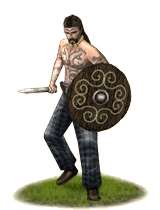 Kluddobro (Klith-ab-ree, "Sword-Bearers") are Briton shortswordsmen. The shortsword is a common weapon, essentially a very long knife or dagger, and used by hunters, and carried by many as a form of self defense. Warriors using shortswords are not generally very well trained, if at all. However, they are readily available, cheap, and have a good charge. They lack javelins or other ranged weapons and are extremely vulnerable at range. Kluddobro (Klith-ab-ree, "Sword-Bearers") are Briton shortswordsmen. The shortsword is a common weapon, essentially a very long knife or dagger, and used by hunters, and carried by many as a form of self defense. Warriors using shortswords are not generally very well trained, if at all. However, they are readily available, cheap, and have a good charge. They lack javelins or other ranged weapons and are extremely vulnerable at range.
Historically, the Celts generally favored spears and shortswords for young or inexperienced soldiers. These warriors, with shortswords, were not necessarily that high up in society; the swords were of debatable quality. Many may not even have fought in battle before, just being hunters or young boys called in to fight, or have chosen to go and fight. Light swordsmen in Celtic society were fairly common, and necessary, often, as a bridge between light and medium infantry, when medium infantry was unavailable. They were increasingly more common during the Roman conquests, as the professional armies with longswordsmen had either been bought by the Romans, or turned on one another, leaving the only defense to these young warriors.
Botroas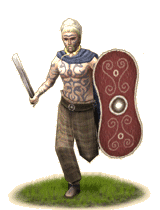 The Botroas (Boat-rows, "Sword Soldiers") are the basic medium infantry of southern Briton and Cisalpine Gaul. They are well trained, with a fair amount of experience, and good quality swords, with javelins to soften an enemy before a charge. Like near all Celtic warriors, they are loyal to a tribal head, who is himself loyal to numerous mounting tiers of nobles, leading to the king. These form the core of the southern armies. Like most Celtic shock infantry, the brunt of their attack is in the charge.
The Botroas (Boat-rows, "Sword Soldiers") are the basic medium infantry of southern Briton and Cisalpine Gaul. They are well trained, with a fair amount of experience, and good quality swords, with javelins to soften an enemy before a charge. Like near all Celtic warriors, they are loyal to a tribal head, who is himself loyal to numerous mounting tiers of nobles, leading to the king. These form the core of the southern armies. Like most Celtic shock infantry, the brunt of their attack is in the charge.
Historically, the Botroas were the younger professional warriors of southern Briton and Cisalpine Gallic tribes. Their lack of armor would leave them vulnerable, but they had great mobility, and their youthfulness included a desire to prove themselves to their people, making them somewhat lacking in fear, or, perhaps, simply more afraid of disgrace than they are of death. The southern Briton warriors looked a great deal like the Cisalpine Gallic swordsmen, and fought in much the same manner.
Iaosatae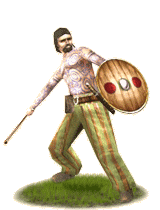 Iaosatae (Yo-sah-tie; "Slingmen") are a varied lot, some young and some old, who've been educated in the art of sling combat. They're quite skilled with their slings, which are truly a deceptively simple weapon. A sling bullet, when slung by a skilled man, will bury itself inside of its target, or break bones. Either way, the one hit is incapacitated or dead. Impressive for what amounts to a leather strip and a rock. The sling is also inexpensive, and with an impressive range. This allows Iaosatae to be both effective and affordable. However, when the distance between them and the enemy is closed, their low expense is quickly made up for in the ease of their breaking and fleeing, as, armed with only light weapons, they are not intended to fight hand-to-hand.
Iaosatae (Yo-sah-tie; "Slingmen") are a varied lot, some young and some old, who've been educated in the art of sling combat. They're quite skilled with their slings, which are truly a deceptively simple weapon. A sling bullet, when slung by a skilled man, will bury itself inside of its target, or break bones. Either way, the one hit is incapacitated or dead. Impressive for what amounts to a leather strip and a rock. The sling is also inexpensive, and with an impressive range. This allows Iaosatae to be both effective and affordable. However, when the distance between them and the enemy is closed, their low expense is quickly made up for in the ease of their breaking and fleeing, as, armed with only light weapons, they are not intended to fight hand-to-hand.
Historically, the Iaosatae would have been a variety of warriors, mostly young men though with little experience in close combat. Few older men continued to use the sling, it would generally be replaced by a spear or sword, but it never fell out of favor with younger men, who could use it for war, games, and hunting. However, their youthfulness, and lack of experience with the grimmer face of combat, makes them prone to run, because, after all, a man fifty meters away with a sword looks a lot different two meters away. Making matters worse for them, their inexperience in close combat means they probably aren't as hardy as other warriors, with more experience fighting in long engagements. Slings were popular with levy warriors in all of Celtic culture, as it didn't take long to train one in the basics, and skilled slingers who went on to become somewhat elite professionals were often well-versed in both sling and short spear combat, meaning an experienced group of Iaosatae would double as impromptu light infantry.
Sotaroas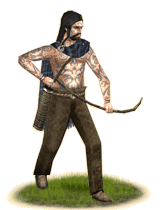 Celtic archers, Sotaroas (Sow-tah-rows, "Bow Soldiers"), while not great or exceptional, are good. They are well trained, disciplined, and can put a fair deal of range behind their attacks. While their arrows aren't too notable, their ability to swiftly pepper an enemy with arrows is always of use. They are not really meant to defeat an enemy force, or even truly damage one, so much as they are meant to irritate and draw attention away from a main force, so it can position itself for flanking. As such, they are good runners, who fire a few volleys as a distraction, and then withdraw to a safe position to hide. If caught in a melee, they would be slaughtered for sure.
Celtic archers, Sotaroas (Sow-tah-rows, "Bow Soldiers"), while not great or exceptional, are good. They are well trained, disciplined, and can put a fair deal of range behind their attacks. While their arrows aren't too notable, their ability to swiftly pepper an enemy with arrows is always of use. They are not really meant to defeat an enemy force, or even truly damage one, so much as they are meant to irritate and draw attention away from a main force, so it can position itself for flanking. As such, they are good runners, who fire a few volleys as a distraction, and then withdraw to a safe position to hide. If caught in a melee, they would be slaughtered for sure.
Historically, archers in Celtic culture had little variety, with only a few truly notable types of archers. They were irritative forces, and intended to soften large enemy forces, but rarely meant to be truly effective in the manner of eastern archers. However, if positioned properly, or experienced enough, they could be truly devastating. Their skill was good, they could fire many volleys swiftly. The Celtic concept of archery was more often to simply blacken the sky with arrows, than it was to fire few, effective volleys. However, their arrows were well made, though not great, and would be capable of puncturing lighter armors, and were quite deadly in their own right. All the same, these men were better off as hunters than field warriors.
Teceitos (Celtic Axemen)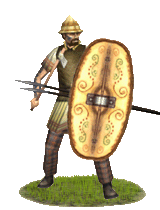 The Teceitos (Tek-ee-tos; Axe Soldiers) are a facet of a Celtic army that is not written about as much as their swords and spears, but many Celtic warriors were buried with axes, particularly in Britain and eastern Europe. The axe is a fine weapon, able to do great damage, even through armor. One can actually strike a man in a mail shirt, not damage the mail itself, but kill the wearer by the sheer amount of blunt trauma dealt to the foe's internal organs. As such, armor stands little chance against these men. They wear leather or padded vests and bronze or iron helmets to help protect themselves. They are light enough to move swiftly over the battlefield, allowing them to flank heavy infantry, and strike them from the sides or flanks. Coupled with their axes and javelins, they are especially valuable at breaking up heavy infantry; they make a great asset to chariots particularly, following the chariots into breaches in the enemy heavy infantry, and cutting open the gaps wider. The Teceitos (Tek-ee-tos; Axe Soldiers) are a facet of a Celtic army that is not written about as much as their swords and spears, but many Celtic warriors were buried with axes, particularly in Britain and eastern Europe. The axe is a fine weapon, able to do great damage, even through armor. One can actually strike a man in a mail shirt, not damage the mail itself, but kill the wearer by the sheer amount of blunt trauma dealt to the foe's internal organs. As such, armor stands little chance against these men. They wear leather or padded vests and bronze or iron helmets to help protect themselves. They are light enough to move swiftly over the battlefield, allowing them to flank heavy infantry, and strike them from the sides or flanks. Coupled with their axes and javelins, they are especially valuable at breaking up heavy infantry; they make a great asset to chariots particularly, following the chariots into breaches in the enemy heavy infantry, and cutting open the gaps wider.
Historically, Celts were, by the late La Tene, mostly recorded using spears and swords. However, in some regions, Britain and Ireland particularly, the axe was still used, and has been found in numerous burials and hordes, and axes are depicted on Caesar's coins of weapons and armor of defeated Gauls. This should not come as a surprise. The axe is easy to make, cost effective, and can be used to defeat armor or shieldwalls. The Celtic axe is not necessarily the largest of axes, but Celtic metalwork is skilled, so their heads are most likely of good quality, and upkeep would be easy for a Celtic warrior, by himself or with attendants. The head would surely keep a good edge, and even without one, a blunt edged axe can still be used to savagely hack a foe apart without the fear of it breaking like a blunted sword.
Calawre (Casse Champions)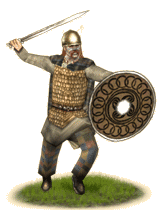 Celts are a collection of hero cultures, and the Britons are no different. Among their southern tribes especially, there are warriors of exceedingly great skill, who use Gallic equipment. The Calawre (Call-a-oo-re; "Champions") are not actually generally real champions, but they wealthy, and skilled. They have good armor and good Gallic swords. They are called champions more because of their appearance than anything; they actually mostly simply fill in the need for more affordable, all-purpose heavy infantry among the Britons. They are skilled, and professional, but their expense generally would keep their numbers low. Celts are a collection of hero cultures, and the Britons are no different. Among their southern tribes especially, there are warriors of exceedingly great skill, who use Gallic equipment. The Calawre (Call-a-oo-re; "Champions") are not actually generally real champions, but they wealthy, and skilled. They have good armor and good Gallic swords. They are called champions more because of their appearance than anything; they actually mostly simply fill in the need for more affordable, all-purpose heavy infantry among the Britons. They are skilled, and professional, but their expense generally would keep their numbers low.
Historically, the Britons had little in the way of 'real' heavy infantry. Most often they relied on wealthy champions to fill that need. However, sometimes they did employ bands of wealthier warriors, who were not necessarily the greatest skilled, but they would be easier to mass in one place than a group of real champions, and, while they wouldn't be AS skilled, they certainly had to have a talent for combat to survive as long as they had to afford their equipment, which was likely imported. However, the Britons also were fond of using leather and bronze scale, which was made locally. These shirts would be lined under with padding, so they could be worn comfortably. Such armor grew far more popular in wake of Roman invasion, due to armor worn by some auxilia being of similar design.
Drwdae (Druids)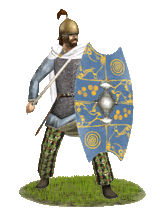 The Drwdae (Droo-day; Druids) are not actually generally warriors. However, there were British warrior-druids; war was a fine profession, and even the best educated of society sometimes engaged in it. These particular Drwdae are warriors, however, and akin in many ways to the Carnutes of Gaul, in that they train a great deal and have the duty of protecting sacred places. They are extremely well motivated and disturbing to enemies, and inspiring to allies, but exist in such small number they're no use alone; they must be supported by other men to fight at their utmost. The Drwdae (Droo-day; Druids) are not actually generally warriors. However, there were British warrior-druids; war was a fine profession, and even the best educated of society sometimes engaged in it. These particular Drwdae are warriors, however, and akin in many ways to the Carnutes of Gaul, in that they train a great deal and have the duty of protecting sacred places. They are extremely well motivated and disturbing to enemies, and inspiring to allies, but exist in such small number they're no use alone; they must be supported by other men to fight at their utmost.
Historically, British druids main duty was philosophical, legal, and religious. Warriors of this class did apparently exist though, in small numbers, acting as what were essentially temple guards, and organizers of defense. While the druids are most notable in late Celtic-British history as having been slaughtered by the Romans at Mona, graves and legends of Celtic history do attest to the druids engaging in combat. In fact, so frightening could they be, conflicts were sometimes averted when the druids took the field in support of one tribe over another; an alliance with the druids meant an invariably great amount of power in Britain.
Cwmyr (Briton Midlander Heroes) The Cwmyr (Koo-meer; "Heroes") are non-noble midlander champions. They carry swords; a rarity among midland soldiers, though these swords are still rather short compared to those of southerners and Gauls. They wear good quality leather armor, that remains flexible and allows them full movement to make use of their shields and swords. Their considerable skill at arms inspires their fellows in battle, and their bravery is noted. The Cwmyr (Koo-meer; "Heroes") are non-noble midlander champions. They carry swords; a rarity among midland soldiers, though these swords are still rather short compared to those of southerners and Gauls. They wear good quality leather armor, that remains flexible and allows them full movement to make use of their shields and swords. Their considerable skill at arms inspires their fellows in battle, and their bravery is noted.
Historically, warriors in the midlands with swords were often nobles or champions. Champions and heroes were used as rallying points in battle, and their own bravery served as an example to others. They would likely be equipped by their local chief, accounting for their sword, and any other fineries or armor. They would live lavishly; such men were awarded well for service, and they expected to be given the best things available. This may lead to sloth in many societies, but Celts are rather unforgiving of those who 'fall from grace', as it were, and they would work hard to maintain their position.
Kluddargos (Casse Sword Masters)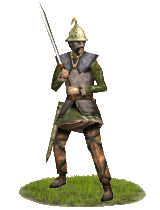 Kluddargos (Klud-arr-gus; "Sword Masters") are British champions who they employ very specialized weapons. Their weapons, longswords gripped in two hands instead of one, with especially heavy blades made to crush armor, require years of practice to master. Able to afford such weapons, they can also afford high quality armor; very fine quality chain shirts. Like other heroes and champions, they are marched to battle to inspire their fellow tribesmen, but their special weapons also give them a tactical purpose; annihilate enemy armor. Their great swings split helmets, smash shields, and collapse cuirasses into the body. These weapons are truly fierce and destructive. The heads they collect will surely be from grotesquely mangled bodies, obliterated by the force of their blows, and the wielders of such weapons likely took an amount of grim satisfaction to find their foes' bodies left in such a state. Kluddargos (Klud-arr-gus; "Sword Masters") are British champions who they employ very specialized weapons. Their weapons, longswords gripped in two hands instead of one, with especially heavy blades made to crush armor, require years of practice to master. Able to afford such weapons, they can also afford high quality armor; very fine quality chain shirts. Like other heroes and champions, they are marched to battle to inspire their fellow tribesmen, but their special weapons also give them a tactical purpose; annihilate enemy armor. Their great swings split helmets, smash shields, and collapse cuirasses into the body. These weapons are truly fierce and destructive. The heads they collect will surely be from grotesquely mangled bodies, obliterated by the force of their blows, and the wielders of such weapons likely took an amount of grim satisfaction to find their foes' bodies left in such a state.
Historically, two-handed longswordsmen were rare but fearsome champions, generally open only to the most wealthy of southern 'Gallic' British tribes who could afford to import the chain, and craft longswords. However, these longswords were made specially with more weight in the final portion of the blade to ensure it would have the ability to crack into armor. They were likely introduced originally as a method of killing other champions, or enemy chieftains, who would be well armored. However, their weapons possibly could be employed akin to the Goidilic and continental equivalents, as wide swinging weapons intended to cut down multiple, lighter armored targets at once, but such wide swings would be awkward due to the weight of the furthest portion of the weapon. Two-handed longswords were not unusual altogether for Celtic peoples, though rare outside of a few regions, particularly the eastern Celtic kingdoms and tribes, such as Lugians, and among the Goidils, but they would likely also be found with Gauls, Belgae, and other Celtic cultures as the weapon of choice for some champions or ceremonial pieces.
Rycalawre (Casse Late Champions)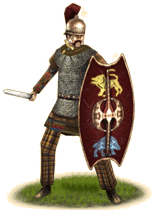 The British tribes best warriors are not so much trained, as they are proven. Young men are trained to fight, but the older warriors grow through real experience in battle. The Rycalawre (Rie-call-a-oo-re; "Kingly Champions") are near fearless, and even more hungry for glory than younger men. They have already felt the rewards of victory, and have many heads to their credit. Their original training has been augmented by years of warfare, often leaving their bodies scarred, but their fighting spirit as sturdy as tempered steel. The Rycalawre are wealthy, powerful men, but they were not necessarily born as such. When a young warrior begins to attract prestige to himself, often by having a mound of heads to his name, he also begins attracting favors and gifts from his chief. These favors, like armor, weapons, jewelry, and slaves, allow him to be outfitted in superior equipment to lesser men, as well as having beautiful ornate equipment and weapons. Any who survived a battle with Rycalawre present, would surely never forget them. The British tribes best warriors are not so much trained, as they are proven. Young men are trained to fight, but the older warriors grow through real experience in battle. The Rycalawre (Rie-call-a-oo-re; "Kingly Champions") are near fearless, and even more hungry for glory than younger men. They have already felt the rewards of victory, and have many heads to their credit. Their original training has been augmented by years of warfare, often leaving their bodies scarred, but their fighting spirit as sturdy as tempered steel. The Rycalawre are wealthy, powerful men, but they were not necessarily born as such. When a young warrior begins to attract prestige to himself, often by having a mound of heads to his name, he also begins attracting favors and gifts from his chief. These favors, like armor, weapons, jewelry, and slaves, allow him to be outfitted in superior equipment to lesser men, as well as having beautiful ornate equipment and weapons. Any who survived a battle with Rycalawre present, would surely never forget them.
Historically, Rycalawre would have been individual warriors from tribes that grew to prominence through having numerous victories and kills to their credit. While individually desiring glory, the Rycalawre would organize into groups to fight in dense shieldwalls. Their elaborate, ornate clothing, weapons, and armor would help encouraged the other men, and surely appeared fearsome to their enemies. Their presence would also encourage their fellows, as they were built up in stories about them as being nearly indestructible, and their own fearlessness would serve as a good example. They would be armed with quality swords, spears, knives, and other weapons, likely given to them as gifts for their service to the tribe. Likewise, their armor was gifted to them, rather than bought by them; likely imported from Gaul or 'Gallic' regions of Britain. This would make outfitting a champion very expensive, but once they have their armor and weapons, they would be otherwise ready to fight. Champions like these would be the vanguard of a powerful chieftain or king's armies.
Myrcharn (Casse Light Cavalry)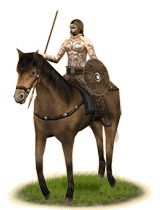 The Myrcharn (Mur-churn; "Mounted Ones") are British cavalrymen. These cavalry are essentially mounted skirmishers. The Britons are based upon infantry though, and cavalry are secondary. They are light cavalry, and incapable of standing too long in a close melee, though their use as extremely mobile skirmishers is of great value against lighter troops or when one doesn't wish to risk valuable soldiers to soften a heavier armored foe. Against longspears or a phalanx, they will almost surely collapse immediately, and should be kept from engaging such weapons directly, though they can be used to pepper such formations. The Myrcharn (Mur-churn; "Mounted Ones") are British cavalrymen. These cavalry are essentially mounted skirmishers. The Britons are based upon infantry though, and cavalry are secondary. They are light cavalry, and incapable of standing too long in a close melee, though their use as extremely mobile skirmishers is of great value against lighter troops or when one doesn't wish to risk valuable soldiers to soften a heavier armored foe. Against longspears or a phalanx, they will almost surely collapse immediately, and should be kept from engaging such weapons directly, though they can be used to pepper such formations.
Historically, the Britons rarely employed mounted cavalry. Chariots, rather antiquated in much of the world, were more favored by the Britons. However, the use of cavalry was still important, though they were more for harassing or scouting operations, and for skirmishing and shock in battle. This allowed them a bit of versatility in mounted combat, but they were still very poorly trained compared to their contemporaries, as horse-mounted cavalry were an afterthought. Such cavalry were used to harass Roman incursions, and most likely others travelling through a tribe's lands unwanted.
Cidainh (Celtic Chariots)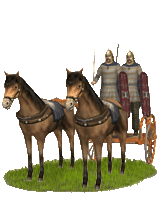 Celtic Cidainh (Kid-unk; Chariots) are an ancient vehicle of war. While soon to fall out of use in Gaul, the Cidainh are very popular in the southern tribes of the Britons, who mingle often with the Belgae, who introduced this type of chariot. The Cidainh is driven into battle, with a warrior riding on the back, who pelts the enemy with javelins. A Cidainh provides rider and driver some modest amount of protection, but the impact they can have in a battle makes them an important target for enemy forces. The mobility of the Cidainh is a bit limited, they have a wide turning radius, making them less mobile than cavalry, but their role as highly mobile skirmishers, with a well armored rider who can focus purely on the enemy, and not having to drive, leaves them with some good practical use. Celtic Cidainh (Kid-unk; Chariots) are an ancient vehicle of war. While soon to fall out of use in Gaul, the Cidainh are very popular in the southern tribes of the Britons, who mingle often with the Belgae, who introduced this type of chariot. The Cidainh is driven into battle, with a warrior riding on the back, who pelts the enemy with javelins. A Cidainh provides rider and driver some modest amount of protection, but the impact they can have in a battle makes them an important target for enemy forces. The mobility of the Cidainh is a bit limited, they have a wide turning radius, making them less mobile than cavalry, but their role as highly mobile skirmishers, with a well armored rider who can focus purely on the enemy, and not having to drive, leaves them with some good practical use.
Historically, chariots in Gaul were falling out of favor, replaced steadily by more mobile cavalry. However, they would still be used at least as late as 230 BC. In Britain, however, the Britons did not face many enemies that would force them to reconsider the role of chariots in then modern warfare. Instead, they would refine the chariots, and continue to employ them for a very long time. The chariots of the southern Britons were almost identical to those of Gaul, as they were both heavily influenced by La Tene culture, which inspired the bronze fixtures and hubs. These were generally more stable chariots than the more northern, Halstatt-style chariots. Traditionally, a Celtic chariot was driven to a battle, and the warrior could pelt the enemy at a distance, then dismount the chariot and engage the opposition on foot, without the slightest amount of exhaustion. If the battle went awry, the chariot would return, the warrior would remount, and ride away from the fight.
Pictone Neitos (Pictone "Painted" Swordsmen)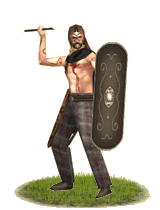 The Pictone Neitos (Pek-tone Nee-yet-os; "Painted Soldiers") are cultic warriors of Teutatis, from the Pictone tribe in Lemovician territory. They are particular amongst Gauls in that they still paint themselves; a practice since defunct amongst most Gallic tribes on the continent, otherwise mostly maintained only by the Belgic and Gallic tribes in Britain; the others who paint themselves aren't generally Gauls. They are braver for their devotion, and use large heavy shields expertly to deflect incoming blows and catch arrows and javelins. Their higher morale makes them more useful than their peers from other tribes at holding gaps and opening up holes in the enemy line. Their charge is powerful and augmented by javelins to soften the target. The Pictone Neitos (Pek-tone Nee-yet-os; "Painted Soldiers") are cultic warriors of Teutatis, from the Pictone tribe in Lemovician territory. They are particular amongst Gauls in that they still paint themselves; a practice since defunct amongst most Gallic tribes on the continent, otherwise mostly maintained only by the Belgic and Gallic tribes in Britain; the others who paint themselves aren't generally Gauls. They are braver for their devotion, and use large heavy shields expertly to deflect incoming blows and catch arrows and javelins. Their higher morale makes them more useful than their peers from other tribes at holding gaps and opening up holes in the enemy line. Their charge is powerful and augmented by javelins to soften the target.
Historically, the Pictones painted themselves ritually with boar designs, and fought painted as such. They would encircle a totemic shrine to Teutatis while painted during their religious ceremonies. During certain festivals, the normal red dyes would be replaced with blood of various enemies in devotion to the tribal god. In other respects, they were the same as most Celtic warriors, and fought in the same manner as other Celts. Gauls had at one time more commonly painted themselves, but this fell out of commonality. Steadily it was practiced by fewer groups, until it was almost totally isolated to a handful of tribes and cults, and to individual warriors. The Pictone cult to Teutatis was strong enough to outlast this social change, and the tribe was even known for the fact that they still painted themselves, as Pictone means "Painted Men"; a testament to how out-of-date the practice was, that it became the defining factor of the tribe.
Balroae (Caledonian Skirmishers)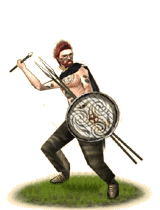 The Caledonians are a fierce people on the edge of the world. Beyond Caledonia stretches a great, empty ocean, and Caledonia itself is home to a rather isolated people. They are seemingly relics of a former era of Celtic history, they do not have great deals of iron, and so do not produce many swords. They instead fight with more practical weapons, spears, javelins, and slings. Balroae (Bal-ro-ee; "Strong Men") are a vast number of men, of many ages and varying levels of experience. Seemingly fearless, and wild, their bodies are tattooed in esoteric spiral designs, their hair is spiked and red, and they are remarkably fearsome. They are very hardy and brave; their lifestyle demands it. Alone, a disciplined army would destroy them, but if incorporated into a more tactics minded commander of the more advanced Britons, they may prove more useful. The Caledonians are a fierce people on the edge of the world. Beyond Caledonia stretches a great, empty ocean, and Caledonia itself is home to a rather isolated people. They are seemingly relics of a former era of Celtic history, they do not have great deals of iron, and so do not produce many swords. They instead fight with more practical weapons, spears, javelins, and slings. Balroae (Bal-ro-ee; "Strong Men") are a vast number of men, of many ages and varying levels of experience. Seemingly fearless, and wild, their bodies are tattooed in esoteric spiral designs, their hair is spiked and red, and they are remarkably fearsome. They are very hardy and brave; their lifestyle demands it. Alone, a disciplined army would destroy them, but if incorporated into a more tactics minded commander of the more advanced Britons, they may prove more useful.
Historically, the Caledonians were never conquered by the Romans, despite Romans successfully defeating them in numerous engagements. The small amount of iron available to them was only enough to produce swords for the most wealthy or greatest of champions. Even bronze armor was a luxury. The Caledonians did not have much cavalry, or any chariots, they only had their own fierce nature as their greatest weapon. Any chariots were likely imported from Hibernian tribes, or Britons fleeing Roman rule, and any cavalry was really just these men mounted on ponies. They were a true relic of a bygone period, still fighting without much in the way of tactics beyond ambushing and mad rushes at their enemies. These people would exist for a long time, until invading Gaels, Germans, Normans, and Norsemen would eventually conquer and assimilate them.
Silurae Birnai (Siluri Warband)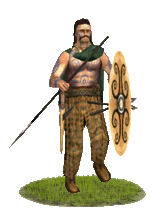 The Silurae Birnai (Sel-oor-ay Bern-ay; Silurii Warband) are a tribe from the south of Cambria. Reknowned for their ferocity, skill, and discipline, they offer up fine spearmen to their lord, braver than most others, and more sturdy and skilled. They are, for all intensive purposes, little more than local spearmen, but of greater trainer and skill. The Silures fill the same role, acting as both anti-infantry and anti-cavalry soldiers, and can also be used to pepper an enemy at distance with javelins. They are disciplined and capable of standing in orderly lines and use tight formations at times to absorb enemy charges. The Silurae Birnai (Sel-oor-ay Bern-ay; Silurii Warband) are a tribe from the south of Cambria. Reknowned for their ferocity, skill, and discipline, they offer up fine spearmen to their lord, braver than most others, and more sturdy and skilled. They are, for all intensive purposes, little more than local spearmen, but of greater trainer and skill. The Silures fill the same role, acting as both anti-infantry and anti-cavalry soldiers, and can also be used to pepper an enemy at distance with javelins. They are disciplined and capable of standing in orderly lines and use tight formations at times to absorb enemy charges.
Historically, the Silures were a bit of an anomaly; they were a somewhat dark-skinned tribe living in the south of what is now Wales, surrounded by much paler Celts. It was postulated by some Romans that they had even been from Iberia originally, accounting for their tone and hair. Irregardless, the Silures were apparently quite loyal. When the high king of the Britons, Caratacus, fled into Cambria to escape the Romans, he was recieved and supported by the Silures, who, though likely they were his vassals, probably had little to actually gain by continuing to support him. The Silures were given their due for bravery though, and ultimately the Romans recruited aide of several opposing tribes to finally successfully subdue them.
|
 |
|
 |






















|